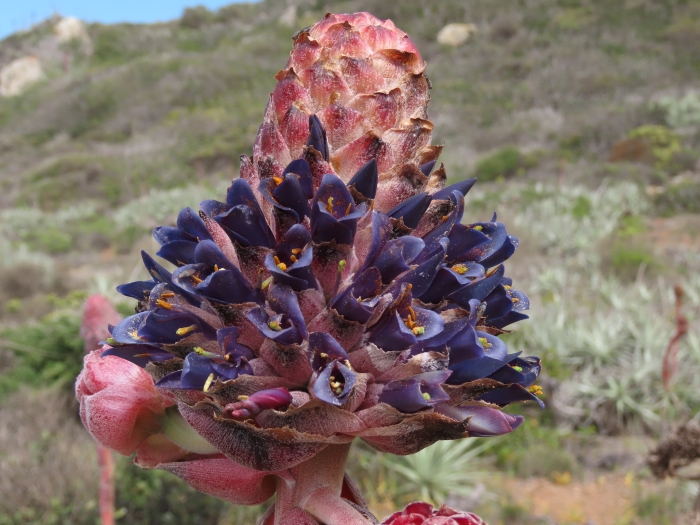Graceful Puya
(Puya venusta)
Graceful Puya (Puya venusta)
/
/

Nicolás Lavandero
CC BY 4.0
Image By:
Nicolás Lavandero
Recorded By:
Copyright:
CC BY 4.0
Copyright Notice:
Photo by: Nicolás Lavandero | License Type: CC BY 4.0 | License URL: http://creativecommons.org/licenses/by/4.0/ | Rights Holder: Nicolás Lavandero | Publisher: iNaturalist | Date Created: 2021-09-30T13:22:30-07:00 |

























Estimated Native Range
Summary
Puya venusta, commonly known as the Graceful Puya, is a perennial herb native to the sclerophyllous shrublands and rocky outcrops of central Chile, particularly in regions like Punta Teatinos and Cerro La Campana. It is often found in association with the endangered Chilean Wine Palm, Jubaea chilensis, within La Campana National Park. This plant typically grows to a height of 1-2 meters and forms a rosette of narrow, spiny, silver-green leaves. Puya venusta produces striking turquoise to metallic blue flowers on tall spikes that can reach up to 2 meters in height, blooming from late spring to early summer. The flowers are highly showy and attract pollinators such as hummingbirds.
The Graceful Puya is appreciated for its unique flower color and architectural form, making it a focal point in rock gardens, xeriscapes, and as a specimen plant in botanical collections. It requires minimal maintenance once established, is drought-tolerant, and prefers full sun exposure. Puya venusta is best grown in well-drained soils, and while it can tolerate some moisture, it is sensitive to overwatering which can lead to root rot. There are no widely known cultivars due to its rarity in cultivation. Gardeners should be cautious of its sharp spines when handling the plant. It has no significant disease issues, but it can be susceptible to mealybugs and scale insects.CC BY-SA 4.0
The Graceful Puya is appreciated for its unique flower color and architectural form, making it a focal point in rock gardens, xeriscapes, and as a specimen plant in botanical collections. It requires minimal maintenance once established, is drought-tolerant, and prefers full sun exposure. Puya venusta is best grown in well-drained soils, and while it can tolerate some moisture, it is sensitive to overwatering which can lead to root rot. There are no widely known cultivars due to its rarity in cultivation. Gardeners should be cautious of its sharp spines when handling the plant. It has no significant disease issues, but it can be susceptible to mealybugs and scale insects.CC BY-SA 4.0
Plant Description
- Plant Type: Succulent
- Height: 1.5-4 feet
- Width: 8-8 feet
- Growth Rate: Slow
- Flower Color: Purple, Red
- Flowering Season: Spring, Summer
- Leaf Retention: Evergreen
Growth Requirements
- Sun: Full Sun
- Water: Low, Medium
- Drainage: Fast, Medium
Common Uses
Drought Tolerant, Fire Resistant, Low Maintenance, Rock Garden, Showy Flowers
Natural Habitat
Native to the sclerophyllous shrublands and rocky outcrops of central Chile
Other Names
Common Names: Ornamental Pineapple
Scientific Names: , Puya venusta, Pitcairnia sphaerocephala, Pitcairnia venusta, Puya coquimbensis, Puya gaudichaudii,
GBIF Accepted Name: